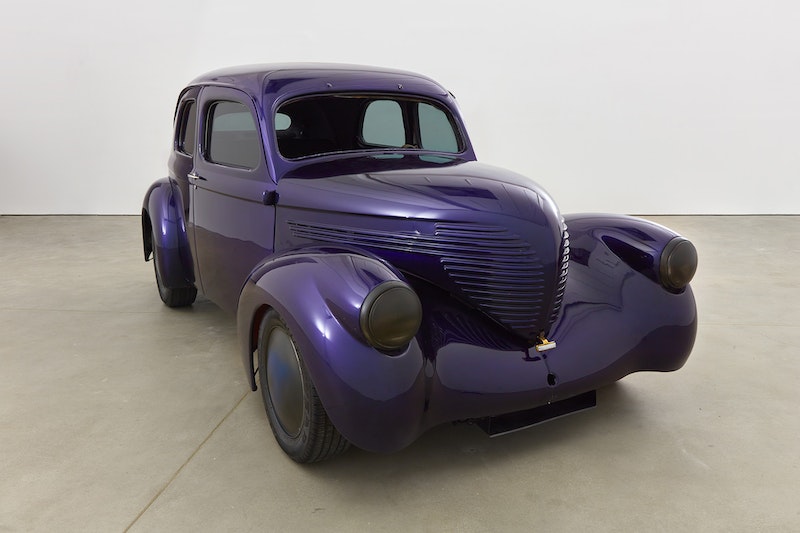February 2024
Download as PDF
View on The Brooklyn Rail

Robert Grosvenor, Untitled, 2023. Automobile, fiberglass resin, auto-motive paint, spray paint, goggles, and rabbit’s-foot keychain, 59 × 67 × 165 inches. Courtesy the artist and Karma.
Elder statesperson of the Minimalist genre Robert Grosvenor continues to grapple with the strong but inscrutable link between exercises in pure form, i.e. Minimalism, and the found object/Readymade. In both cases there is a superficial lack of narrative: the ubiquitous “it is what it is.” But this isn’t really the case, because with Grosvenor, the existing conditions are tweaked to such an extent, that “it is what it is” becomes “more than meets the eye.” In the current exhibition at Karma, Grosvenor has produced a duet of odd attraction. Two works, both Untitled (2023) occupy the gallery. One emerges from banality—a wooden plank screwed to the gallery’s west wall. The second begins with a hiccup in normalcy: a deep purple sports car, which is further modified to a degree of uselessness. There is formalism here—the pure appreciation of color and saturation, the style of the car, as well as how we exist in the presence of these elements, but there is artistry in the discrepancies which force their presence on our consciousness.
The process at work is reminiscent of John Cage’s Works for Prepared Piano. Grosvenor modifies and manipulates and transforms his objects in unexpected and sometimes aberrant ways—much how Cage wrote for a “prepared” piano, where the sound created by the instrument was affected by the placement on its strings of screws, bolts, wool, coins, bamboo, and sundry materials. These additions made its output different, discordant, and added sounds which rejected our notion of aesthetics. Similarly, the headlights and hubcaps of Grosvenor’s modified purple 1941 Willys Americar are blacked out with spray paint. He does this with a purposeful haphazard inconsistency, not evenly or precisely. His lack of care indicates that he is not trying to somehow trick us into thinking the car came this way, or that it is part of a careful or machine-like modification (though the irony of course is that this is incredibly carefully orchestrated). This vintage car connoisseur’s object of beauty has been palpably fucked up. It’s the deviation from the norm in things we are vaguely aware of that seem to make us look more closely at them. Similarly, the wooden plank on the wall is sprayed black, with special care that the paint bleeds beyond the object onto the wall. This is a messy Minimalism indeed, and messy architecture too—almost evoking a level of hostility in its refusal to bend the knee to accepted practices of neatness and craft.
Grosvenor instigates questioning by implying a narrative. The purple car lacks a windshield. This is a detail within a trajectory of details that have been carefully planned. The other four windows are tinted, making observation of the interior of the car difficult except through one position. The leatherette seats are painted purple as well, and there is a rabbit’s foot keychain dangling from the ignition key and a pair of driving goggles on the steering wheel, which you will definitely need to drive, as there’s no windshield. For me, the gates were opened to any number of American road and car narratives, mostly clustering around the film noir of David Lynch, but also a Back-to-the-Future nostalgia: escape, non-conformity, crime. Grosvenor’s premeditated ability to activate these associations is a novel thread in conceptual object-based art, one could have been in the Whiskey Pete’s Casino in Primm, Nevada, looking at Bonnie and Clyde’s getaway car (their Ford V8 actually resembles Grosvenor’s Willys, to this novice’s eye). The wooden plank, placed at eye-level, around the same height as the roof of Grosvenor’s Willys becomes something of a calibration point between viewer and space. While we acknowledge its comment on architecture, its proximity to the car forces it into a dialog with both the other work and ourselves, our relative heights, our position in the gallery, our sense of self. Seemingly part of the plan, we also become an object in the room, an actor in Grosvenor’s mysterious narrative.



